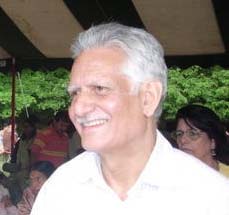Diwali Celebrations by Kashmiri Pandits
Piyaray Lal Raina
October, 2000
ORIGIN
The origin of Diwali
is very obscure. However, present day beliefs for this celebration are
as under : celebration are
as under :
SAGAR MANTHAN
Sage Kashyap
was married to all the 13 daughters of Sage Daksha Prajapati and from the
children born from his first wife ADIT were DEVAS whereas the children
from his second wife DITI were DEMONS. DEMONS were physically more
powerful and scarred DEVAS who approached Lord VISHNU for help. He suggested
away out. That was to churn the ocean for getting nectar, by drinking which
the Devas could become immortal and out of reach of Demons harm. Devas
agreed to his proposal and got ready for the job. 14 objects emerged from
the churning of the ocean. Nectar was 12th which was readily consumed by
Devas and they became GODS. 13th object was KAL-KOOT (poison) which no
body was prepared to have. In order to save mother Earth from the pollution
of poison Lord Shiva came forward to take it. He took it and held it in
His throat. By this act His throat turned blue due to the effect of poison
and hence He is called by the name of NEELKUNTH as well. Last object to
emerge from the churning of the ocean was Goddess LAXMI seated in a lotus,
holding precious jewels, wearing garland of imperishable Parijita flowers,
looking prettier than anything known till then. She was immediately taken
by Lord VISHNU as His consort. Ever since Laxmi came to be associated with
not only good fortune and material wealth but also embodiment of loveliness
gracefulness and charm.
The churning process started on the 11th day of Kartik Krishan paksh
and ended on Amavasya as per our Lunar calender.
LORD RAMAS RETURN
Some believe Lord Ram (who is incarnation of Vishnu) returned home on this
day after 14 years of exile along with his wife Sita (who is incarnation
of LAXMI )
CELEBRATIONS
Hindus celebrate this day with great festivity. No
other deity's worship requires as much massive cleaning except for Shivratri
celebrations by our community. People decorate their houses much in advance
in preparation of this festival. Some give a new paint to their homes
while others clean their homes thoroughly. This is the occasion for buying
new things - a new home, a new car, furniture, clothes, utensils etc. In
some parts of India celebrations last for one week starting from Ekadashi
and ending two days after Amavasya. Since Laxmi is associated with material
aspect of life, it is the most auspicious and important celebration for
people associated with any business/commercial activity. It is the beginning
of the fiscal year for their accounts/books.
On the day of Diwali people get up early in the
morning and then put on new clothes, go to temples, and purchase lots of
sweets and dry fruit for distribution among friends, relatives and collegues.
They also purchase earthen lamps, candles, electric and electronic devices
for illuminating their homes and business establishments. For children
it is a day of merry making. They enjoy by playing with crackers
especially at night time. They also receive cash as Diwali Gifts. All government
and private establishments remain closed on this day. Business houses reward
their employees with gifts of cash and kind. In some homes gambling and
drinking is considered part of celebration process. Winning is considered
a sign of good luck for the coming year.
WORSHIP
The elders of family keep a fast until evening. Goddess
LAXMI along with God GANESH is worshipped after sunset. Some people purchase
new 'murties' made of clay or silver or even gold. Prayers are offered
with or without a family priest. Sweets, dry and fresh fruits, cereals
flowers etc. are offered with prayers.
CELEBRATIONS BY KASHMIRI PUNDITS
Deepawali is one of the oldest rituals for Kashmiri
Pundits. We find a mention of its celebrations in Nilmat Puran. It was
then celebrated as SUKHSUPTIKA which literally means sleep with happiness.
The celebration would start from Ekadeshi and last on Amavasya. On Amavasya
elders of family would keep a fast and worship goddess LAXMI after sunset.
Earthen lamps were placed in temples, on the road crossings, cremation
grounds, banks of rivers, streams and lakes
hills houses, at the foot of trees, cow sheds,
court yards and shops. People would wear new clothes and listen to music.
With the passage of time some of these things
have become obsolete but the tradition is still there. Since we were not
used to eating Sweets in Kashmir, we substituted sweets with sweet puris
and offered the same to Lord NARAYAN (incarnation of Lord Vishnu).
On the whole we do not celebrate Diwili with the
same gusto as is done by our Hindu brethren outside Kashmir. This could
be due to the fact that we are Lord SHIVA worshipers. Diwali is primarily
a worship of Lord VISHNU who is very popular in the plains of India.
| 